When we start working on a new project, the primary thing that ensures successful implementation is the right approach. Software development uses different project management methods. Still, two of them are compared the most: agile vs waterfall.
Each of the two approaches is suitable for particular types of projects. In this article, you’ll discover a detailed comparison of agile vs waterfall pros and cons. So, you’ll know how to use these two methodologies for your projects development.
Waterfall model vs agile: what is more popular?
Software development lifecycle (SDLC) follows strict phases to deliver the best result for a project. It is a single process that varies in the two most popular project management methods, agile and waterfall.
As Statista’s survey shows, 32% of respondents use the agile approach in software development compared to 10% who use the waterfall method.

Source: Statista
A waterfall methodology is a traditional approach in software development. The waterfall method was predicted to disappear for a while as the delivery process was slow and required many deliverables.
Today, the agile vs waterfall statistics shows that the agile model is more popular than the waterfall one. Despite this, the waterfall model still holds a prominent position in software development.
Let’s see how they differ and what approach best suits for particular solutions, agile or waterfall.
What is agile?
Agile is adopted in the majority of companies today. As the State of Agile Report shows, 95% of the surveyed companies practice agile. Mainly, they value the agile model for managing changes and accelerating product delivery.
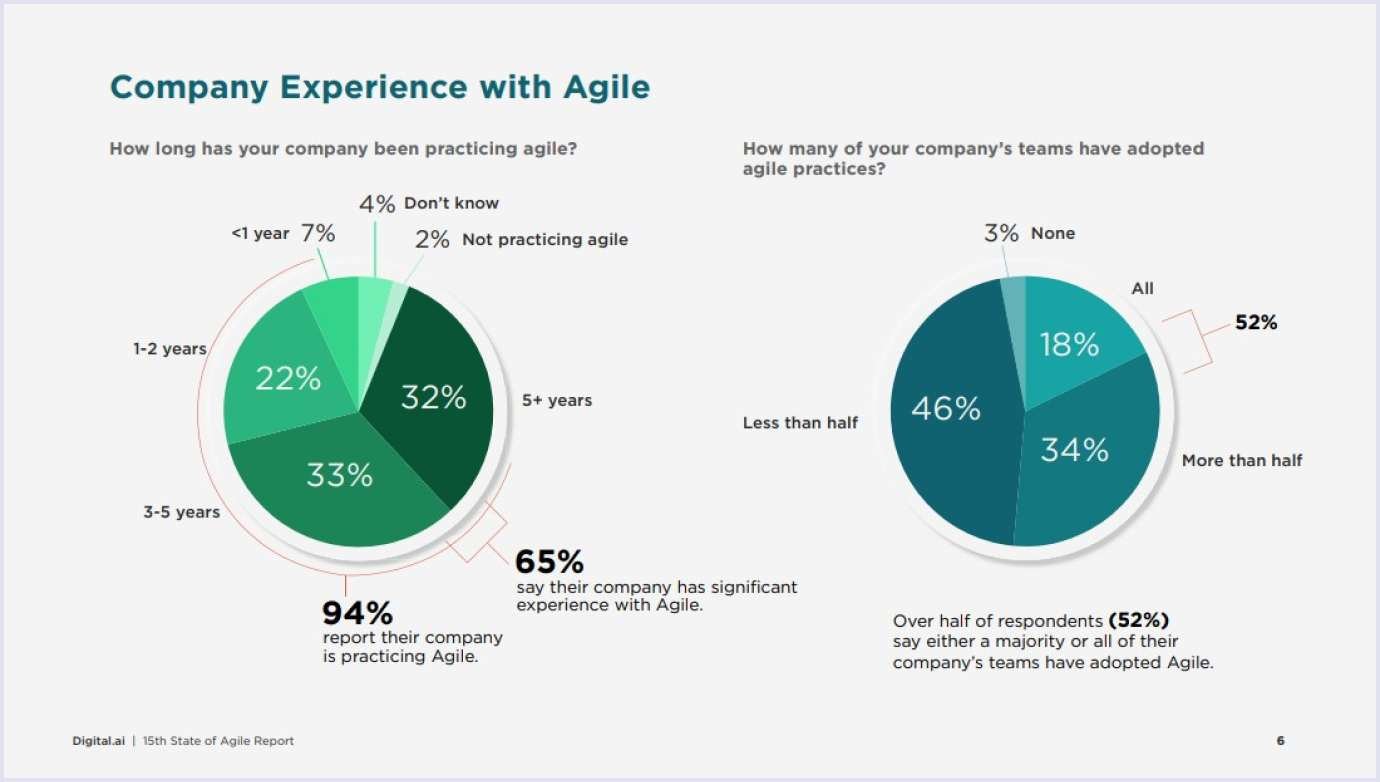
Source: 15th Annual State of Agile Report
Let’s see what the agile method is and which projects it suits best.
Agile project management is an approach in software development that focuses on flexible steps to reach the set goal. It enables the team to make changes and modifications swiftly.
Aiming at flexibility in development can be traced back from the 1950s - 1970s. In the 1990s, lightweight software development methods appeared. They were opposed to heavyweight methods, often called “waterfall”.
In 2001, a group of software developers discussed lightweight development methods. As a result, they published the Manifesto for Agile Software Development. The values proclaimed in the Manifesto come from the developers’ experience in building software. They highlight the importance of the team side and plasticity of development processes.
Agile uses an incremental approach and is more flexible. Such an approach is used in specific agile methodologies, for example, Scrum. Let’s take a closer look at this method to better understand the agile principle.
How does agile work?
The agile model allows moving through a project in small steps. For example, the steps in the Scrum project management methodology are called sprints. They are short phases with a duration of around two weeks.
Below you can see the framework with sprints presented by Scrum.
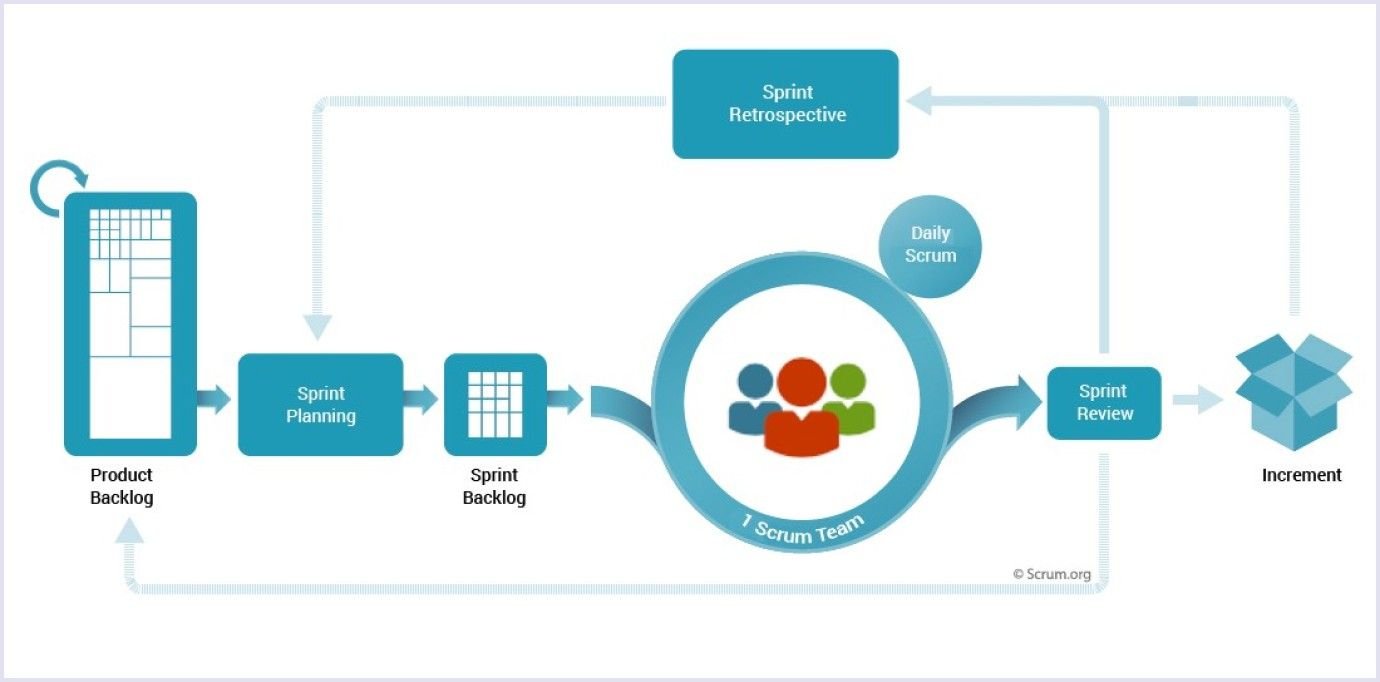
Source: Medium
At the beginning of each sprint, the development team outlines the list of deliverables based on the customer's priorities. At the end of the sprint, the team and customer discuss and assess the sprint results by making notes for further sprints. Each sprint defines deliverables during agile development.
Agile encourages teamwork and the high involvement of a customer in the development process. The agile team members and the customer review the results for each sprint daily and weekly adjusting the tasks accordingly. At agile project management, the customer is involved in each sprint.
At Codica, we prefer the agile approach. It allows us to get feedback from a client and to make modifications through custom software product development services.
Related reading: Agile at Codica: How We Deliver Great Web Projects
Advantages of agile vs waterfall
If we compare agile vs waterfall methodology, there are such pros of agile:
Moving in small steps with iteration. Agile development implies moving in short steps. Testing is conducted at each step. So, the team changes the agile project according to the results obtained.
Flexible. The agile development benefits include continuous discussions of the requirements and delivered results. Each step discovers how successful it is and what improvements can be made in project development. Agile teams are flexible, so, if necessary, the project direction can be changed. Also, different development phases can be performed concurrently. For example, testing can be conducted while development is in progress. Thus, agile methodology allows the teams to focus on business value and deliver better outcomes. Flexibility is one of the crucial aspects when choosing between agile or waterfall.
Enables continuous improvements. The team and customer discuss the requirements at each step. Communication in agile is an essential part of the project delivery. It brings better end results in agile development.
Values stakeholders’ feedback. The customer gives valuable input to the development team and participates in creating the product. This helps understand the desired project results and simplifies the software development process.
Empowers teams. The benefits of agile include team cooperation. The team works together at each iteration of the agile project and continuously communicates. So, if changes are needed, the team easily makes them. The agile model facilitates the work of development teams as the changes can be implemented fast.
Speeds up delivery of a product. If time-to-market is important, the agile methodology is helpful as it allows faster delivery of working software. The product won’t include the full set of features, but it can be delivered to the public. It allows gathering user feedback and discovering what improvements should be made.
To sum up, the agile approach allows transparency of the development process. It enables delivery of complex solutions quickly. For example, we used the agile approach to deliver a boat sales marketplace Trade A Boat. It is a solution that helps people buy and sell boats and marine equipment based on specific criteria.
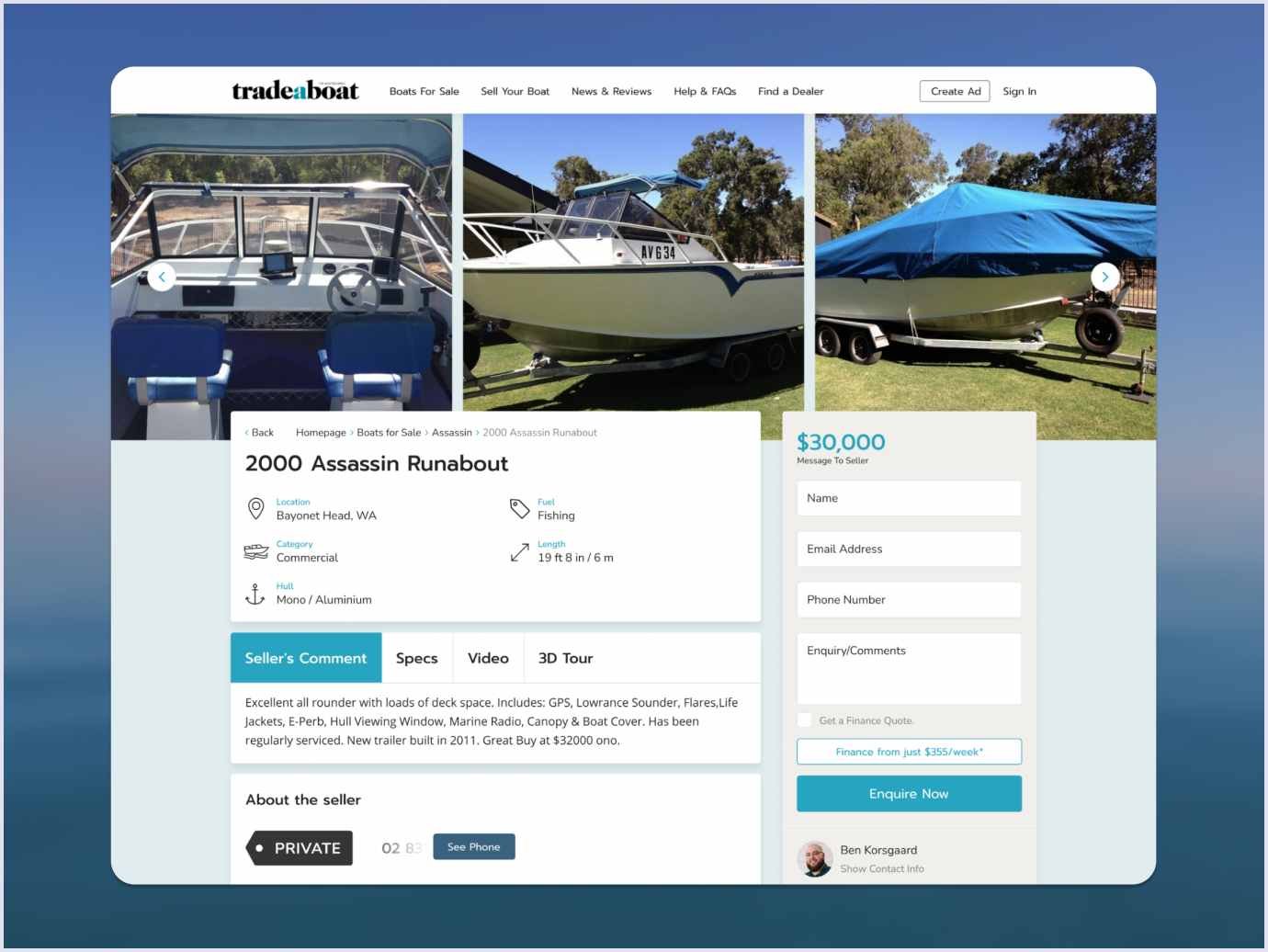
Disadvantages of the agile approach
Higher customer involvement. Though this point is helpful when a customer cooperates closely with the team, it requires time and effort. Some customers would prefer to rely on the team and save time for their input in a software development project.
Robust change management required. Due to continuous changes of priorities in agile, certain features will not be built within the allotted time. Also, the customer who participates in the agile development process may add features. This will increase time and cost needed for the project. So, solid change management may be needed.
Frequent redesigning. A complex solution should be discussed at the start of development. The agile methodology doesn’t allow for such an approach. So, the agile system will need redesigning to maintain its high quality. It is an especially crucial aspect in systems with high-level architecture or integrations.
Team location in one place is not always possible. Agile development requires close project team work. So, it’s better for the team to be in the same location. Meanwhile, there are collaboration tools that facilitate communication bringing it online.
Self-management required. The entire team should be completely dedicated to the project development. Otherwise, the teamwork will weaken, bringing poor results.
The benefits of agile development are about customer satisfaction, which is a focus of this approach. Customer feedback at each step helps find better ways for development of a solution.
For example, Codica uses this approach for building products with different complexity, such as PWA development services or SaaS solutions.
You may also like: Avoid These Costly Mistakes During Web Application Development
Top tools for agile development
Jira. Initially, this software was built as a bug-tracking tool for developers. Today, developers and project managers use this powerful tool to plan and accomplish tasks. The Jira tool is flexible and customized to users’ needs. An option of using it with Scrum and Kanban frameworks makes it convenient for managing agile projects. Its drag-and-drop interface allows transparent planning workflows and assigning tasks to agile team members.
Trello. Along with Jira, it is a program managed by Atlassian. Trello is widely used and known for a range of integrations with various tools used in project management. Trello cards allow you to attach documents, write comments, create checklists, and more. You can integrate Trello with Jira to get most of these top agile tools.
ActiveCollab. It includes various features for task management, time-tracking, invoicing, and more. A comprehensive calendar shows everyone’s roles and progress against time estimates. The solution is adapted for the work with written documents and integrates with email tools. Also, it allows you to track billable hours.
Axosoft. This tool allows team members to create plans and plot process steps. It has a team wiki that enables sharing information within the team. Axosoft turns customers’ emails into support tickets. So, a project team can respond to customers promptly, which saves time for communication.
Also, you can choose among the below agile tools.
Types of development projects that the agile approach suits
The agile development process suits the project with a fair amount of uncertainty in requirements. It is best for projects where multiple features must be designed for integrations with other systems. Also, the agile development methodology suits the projects with non-fixed funding.
So, agile is used for development projects with incremental progress and complex design. It usually implies a non-sequential project timeline.
Exciting projects created with agile
A group of volunteers in Wikispeed created an eco-friendly car in 2011 using the lean startup and scrum approach. Not only they applied the scrum method to organize their work process. Their car also went agile as it consists of modules. So, if you need to change an engine, you don’t need to reassemble the whole car.
The Jet Propulsion Laboratory, a research facility managed by NASA, uses a set of Atlassian tools. They apply JIRA, Confluence, and Bamboo modules in the workflow. So, the laboratory builds software for flight mission planning. The agile method also helps the laboratory handle the data received from the Mars Curiosity rover.
Atlassian upgraded the BAE Systems Australia, one of the largest defense suppliers in Australia. They deployed Jira Service Management within three weeks in their organization. BAE Systems saved $600,000 in the first year of applying the agile methodology. Furthermore, the organization estimates to save $1.62 million over the next five years.
What is waterfall?
The waterfall model is similar to agile in aiming to deliver a high-quality solution. Both go through the same phases of planning, developing, and monitoring. But the way of development is different in waterfall and agile.
The first description of the sequential approach appeared in 1970. Winston W. Royce, a prominent American computer scientist, presented a detailed diagram. It included specific development stages that were later known as the waterfall phases. This diagram reveals the core of the waterfall approach.
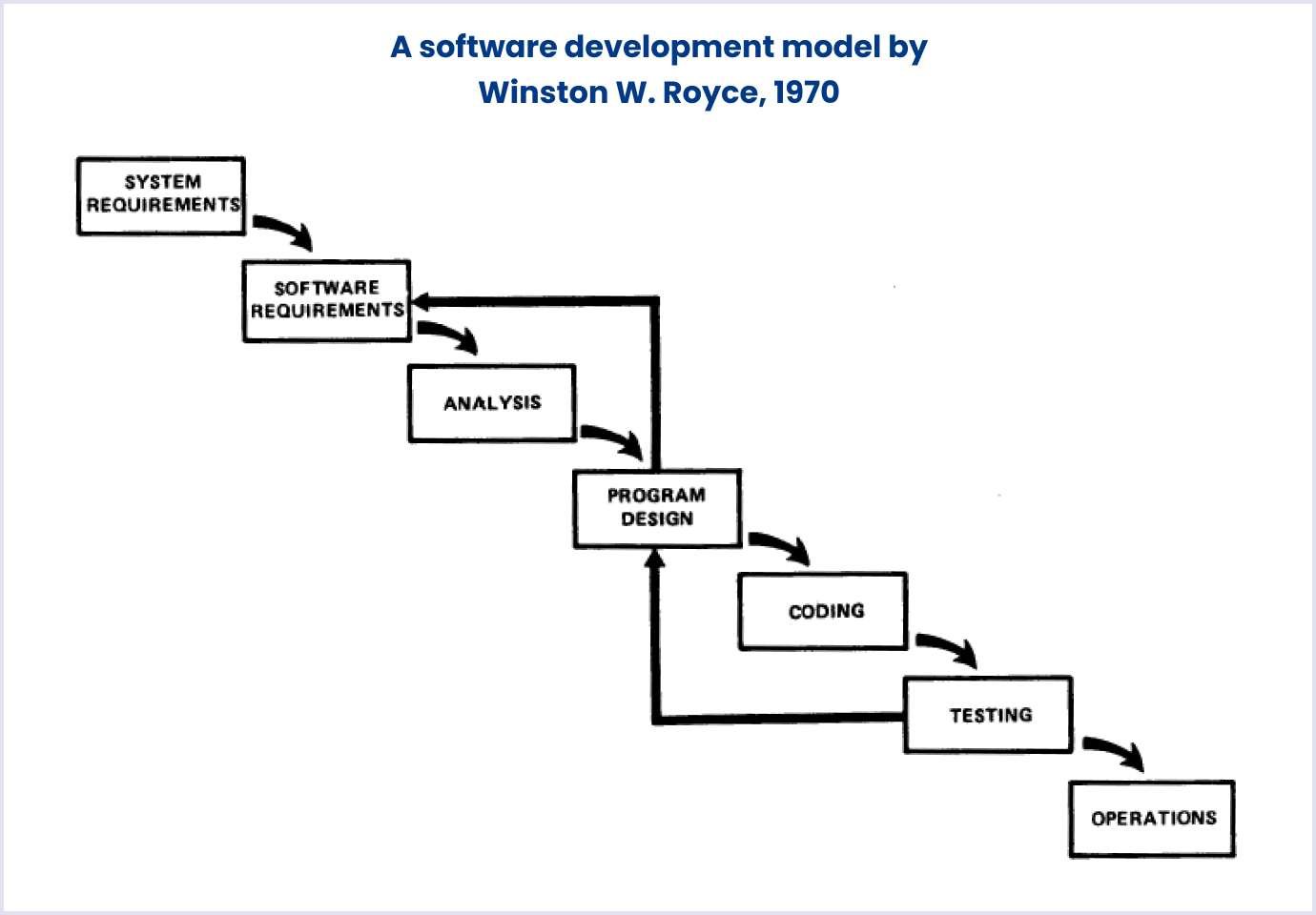
Source: Wikipedia
In the late 70s, T. E. Bell and T. A. Thyer published an article based on Royce’s findings. They were first to use the term “waterfall”.
The authors reflected their experiences in software development for spacecraft missions and systems. So, IT and other domains used the waterfall approach until the early 2000s, when agile appeared.
The waterfall development process divides the software development into distinct phases. Each next phase in the waterfall methodology starts after the previous phase is completed. It produces a deliverable that should be approved before proceeding to the next step. This is the primary difference between waterfall and agile.
In waterfall project management, all phases are performed once. Unlike agile, this linear approach means that all the requirements are discussed in the beginning. It enables providing accurate information to the team on planning, schedules, budget, and resources.
The sequence of events in the waterfall methodology typically includes the following steps:
- Product requirements definition;
- Design;
- Coding;
- Unit testing;
- System testing;
- User acceptance testing;
- Fixing issues;
- Delivering a finished product.
Each represents the finished step, and the next phase begins after the previous one is finished. There is also an interruption between each step. For example, the customer needs to approve and sign the project requirements before the design step begins.
Related reading: What Is Project Discovery Phase in Custom Software Development
Advantages of the waterfall approach
If we compare waterfall vs agile methodology, the former has such pros:
Straightforward planning. The customer and project team agree on the needs and schedule at the beginning of the project development. So, building a product moves from start to finish.
Defined scope and duration. As the full scope is defined at the start of the software development, it is easier to measure the progress.
Defined duration. The waterfall development strategy facilitates defining the time for project delivery.
Consistent software design. The whole picture of the future software is defined during the project discussion. It brings the design consistency for the product. Thus, it eliminates the need to adjust the design as in the case of compiling small pieces of software together in agile.
Easier costing. The waterfall software development allows predicting the needed costs. The requirements and needed functionality are discussed when planning the project delivery. Such an approach enables estimating costs at once, leaving out the need for recalculations.
Clear measurements of progress. The product delivery is divided into separate phases. Typically, they include design, coding, testing, and more. Completing each phase means successful progress in the product delivery.
Defined team roles. The waterfall methodology allows distinguishing the roles needed for software development. They typically include a designer, frontend developers, backend developers, and more. Such assignment of roles brings clarity when the team members perform the tasks.
The team members can handle other tasks. Throughout the software development, the team can proceed to other tasks if they are not involved in the current project. For example, testers can prepare the scripts from the specification while the design and coding are in progress.
A customer is less involved. The customer participates at the start when the requirements are defined for the development project. Also, a customer is involved in the end when the project’s compliance is discussed.
Disadvantages of the waterfall approach
Rigid structure of the project. The waterfall methodology doesn’t allow for modifications in a plan. The changes that arise during the SDLC offset delivery as they require the project restart.
Testing at the later development phase. The waterfall model implies testing in the later phase of development. So, if there are any flaws, they are discovered after the product was built. It may lead to redesigning the whole product involving more time and resources.
Complications with the delivery of large development projects. Complex projects that include many functions take a long time to develop. Also, there may be discrepancies between the requirements and delivered results. The changes in the waterfall process will be more costly.
Limited customer involvement. The waterfall approach involves the customer in the project start and finish. The customer sees the product when it’s ready, and the result may differ from what the customer expected. So, this may lead to poor customer satisfaction, even if the team worked according to the requirements.
Customers find it challenging to understand the whole project. Sometimes the layouts of the development team give the details that a customer fails to understand. The situation can be improved, though, with simple explanations.
Top tools for waterfall development
ProjectManager. It includes Gantt charts and task lists along with Kanban boards. The tool includes features for many methodologies so that users can select the best one for each project. It has unlimited file storage where you can collect documents. Also, the solution allows tracking the task progress.
Smartsheet. This online software has a spreadsheet-like interface. It has views like the grid, calendar, and Gantt. You can create schedules and plans with it and track the progress of projects with reports. It also includes waterfall project management templates and eye-catching card views. The software also supports agile projects.
Mavenlink. It is an online tool for project management that uses Gantt charts. The tool allows tracking your tasks’ progress and checking if you meet deadlines. In case of changes in team or resources, you can easily change their priority. Mavenlink supports waterfall methodology, as well as agile and hybrid models.
Zoho Projects. This cloud software offers profound features, such as Gantt charts and billing recording on many projects at once. It provides high communication capacity with chat boxes, forums, and Zoho Meeting. Zoho Projects suits waterfall development projects. If you need an agile approach, you can switch to Zoho Sprints.
Types of development projects that the waterfall approach suits
It is best to choose the waterfall model for a small-size single project with defined scope and budget. The scope of such software projects is clear in the beginning. So, they can be delivered in a straightforward manner from start to finish. In this case, waterfall is better than agile.
Also, the waterfall is advisable when a customer prefers predictable project management. Furthermore, the customer is less involved in the waterfall project development.
Though agile is used in many industries, there are areas where the waterfall approach is preferred.
For example, the waterfall is valued in such domains as:
- military,
- healthcare,
- construction.
The waterfall approach relies on fulfilling the documentation requirements. So, it matches with conservative approaches and long-term projects in these domains.
You may also like: Work from Home Trends: Future of Remote Working
Agile vs waterfall comparison
Below you can see the comparison of agile and waterfall methodologies. It reflects the difference between agile and waterfall in crucial aspects.
| Agile | Waterfall | |
| Development process | Incremental and iterative, development in recurrent short steps | Linear and sequential, moving from start to end |
| Steps | Sprints | Phases |
| Number of projects handled at the same time | Many projects | One project |
| Focus | Focused on a customer’s satisfaction | Focused on successful delivery according to the plan |
| Frequency of preparing requirements | Requirements are prepared at every step | Requirements are prepared once |
| Flexibility | Allowing for changes in requirements | Avoiding changes in the project scope |
| Testing | Concurrently | After building |
| Involvement of a customer | Customer is involved at every step of development | Customer is involved in the start and in the end of development |
| Involvement of a project manager | Project manager is involved along with the team | Project manager coordinates the whole work |
| Involvement of development and testing teams | Development and testing teams can make changes to the requirements | Development and testing teams cannot make changes to the requirements |
The waterfall vs agile infographic below shows how the development phases are organized in both methods.
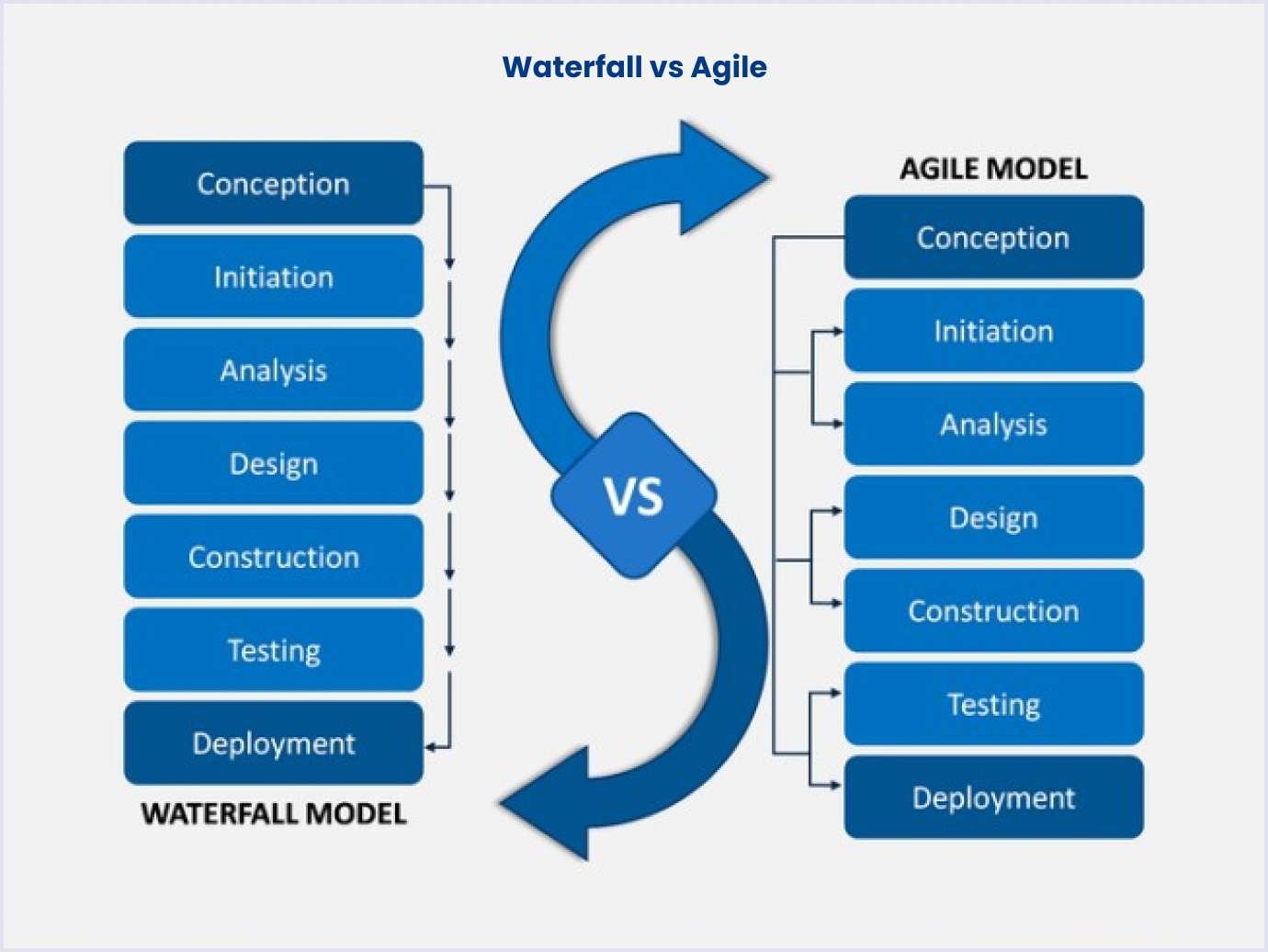
Source: sketchbubble.com
Related reading: 5 Powerful Tips to Become a Successful Project Manager
How to choose between agile vs waterfall for your project?
The agile and waterfall methodologies have different purposes. Some projects need an incremental approach. Others are better implemented with a sequential approach. So, when choosing between them for your project, decide on the project goals and priorities.
Choose the agile project management if:
- Your requirements are flexible and changeable during the development process;
- The project’s scope and features can be modified;
- You are ready to give feedback to the software development team.
Choose the waterfall project management if:
- Your requirements are set at the start and are not changeable;
- The project’s scope is clearly defined and shouldn’t be modified;
- You prefer to rely on the development team to avoid the changes through the development process.
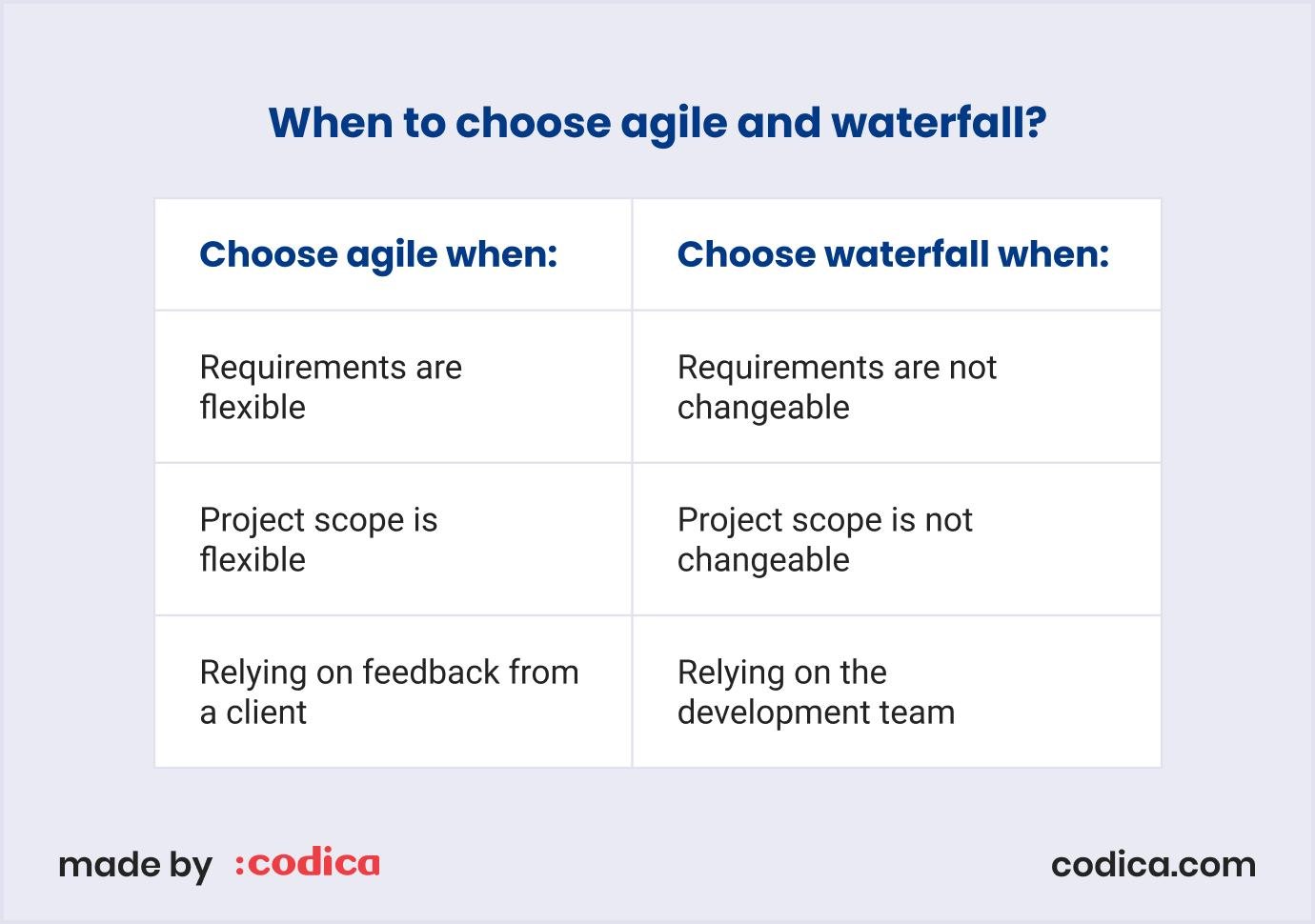
Codica’s choice
When it comes to project management style, we choose the agile methodology with the addition of the scrum approach. We perform weekly meetings to see the close goals and expected outcomes. In addition, Codica’s development methodology implies daily standups. They are necessary to discuss achieved results and plans for the next step.
We prefer getting feedback from a client at every phase in the development process. The customer’s notes are valuable as they help us optimize the SDLC when we deliver projects.
Implementing this approach has helped us deliver many successful web products. For example, this is how we created an online travel marketplace for iExpedition. Moving in sprints and with the client’s involvement, we delivered a solution that exceeded the expected sales volume.
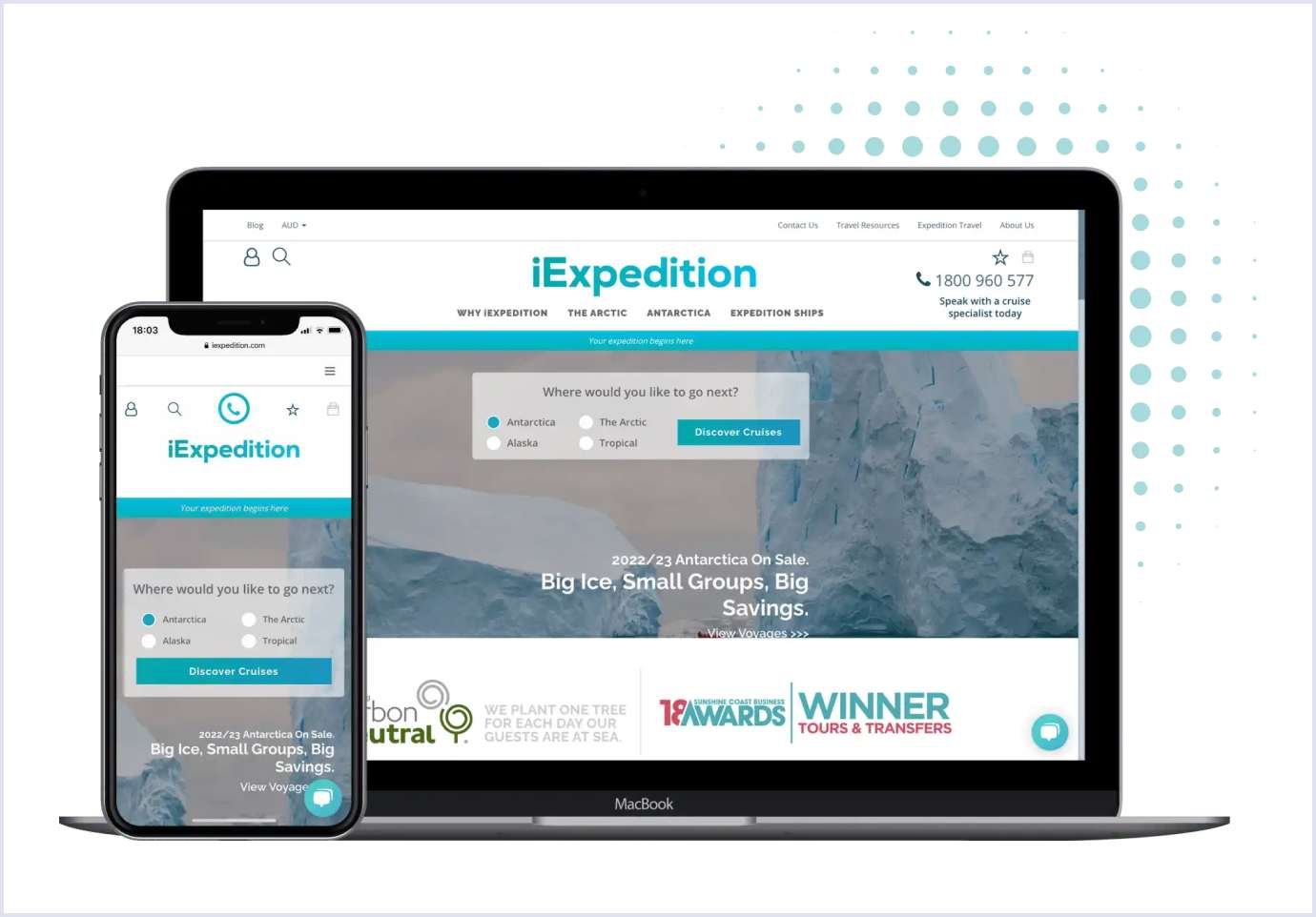
We are fans of full transparency in the development process. So, we always ensure that our clients have all the up-to-date information on their project status. At Codica, we analyzed the strengths and weaknesses of the agile approach and adopted it to deliver better results. Check our projects that we’ve delivered with agile development.
What are the benefits of agile and waterfall?
Both methodologies are valuable. The agile model is flexible and relies on teamwork and client feedback. The waterfall approach is straightforward, so the project is delivered following specific phases.
We advise you to choose the agile approach if you need flexibility in development. The waterfall method is better for small projects with clear tasks and defined budget. Knowing the agile vs waterfall pros and cons, you can make the right choice.
If you need to create a solution and implement it using the best project management practices, contact us. We’ll use our methods to bring the best result for you.

